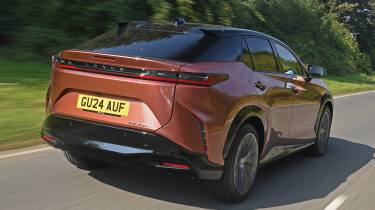New Lexus RZ 300e 2024 review: range boost makes EV more appealing
The Lexus RZ 300e has one motor less than the more powerful RZ 450e, but gets some big boosts in efficiency as a result of

Verdict
The Lexus RZ 300e makes much more sense with the added efficiency that comes from the loss of a motor, even if its range still isn’t up there with its rivals’. Interior quality and design are still excellent, and for some the RZ will be worth a look based on the cabin alone. Combine that with a driving experience that sensibly targets comfort, plus loads of rear passenger and boot space, and the RZ looks like an appealing package.
Although the Toyota bZ4X and Subaru Solterra are decent competitors in the all-electric family SUV sector, we’ve been underwhelmed by them so far. Back in 2023, Lexus weighed in with the RZ – which uses the same EV-dedicated e-TNGA platform as the Toyota and Subaru – but in 450e guise it fell flat. Now we’re trying the RZ 300e edition.
The initial impressions are good. While the RZ 450e delivers a range of 272 miles (252 miles when fitted with bigger alloys), the 300e can go up to 297 miles. However, the extra range doesn’t come from a bigger battery, because the 300e uses the same 71.4kWh pack as the 450e. Instead, the new version has front-wheel drive and a single electric motor, compared with the all-wheel-drive, dual-motor set-up in the 450e.
Used - available now
Inevitably, that slows the RZ’s acceleration, because with just one 201bhp electric motor, the 0-62mph sprint takes eight seconds flat in the 300e; the 450e will do it in just 5.3 seconds. Although the instant torque of the electric motor gives the RZ 300e some initial punch, this fades pretty quickly and you soon understand that acceleration figures aren’t what the RZ is about.
The 18-inch alloy wheels in our lower-spec Premium car not only improve range by 31 miles over the 20-inch rims on the Premium Plus model, but they also contribute to excellent ride quality. The RZ glides over bumps and potholes, and its road manners are refreshing in the face of a tide of electric family SUVs that often inappropriately prioritise chassis stiffness and sportiness. Neither the bZ4X nor the Solterra can give you the same levels of refinement as the Lexus, which is supremely quiet at cruising speeds.
That’s not to say the RZ falls apart at the sight of a corner, though. The new ‘by-wire’ steering might be light and lacking in ultimate feedback, but body roll is composed and manageable. The Lexus is noticeably front-driven in the bends, but it doesn’t scrabble for grip, even in the wet, thanks to some wide front tyres and even wider rears. While the brake pedal itself gives plenty of pushback, the levels of brake regeneration aren’t strong, with no option for one-pedal driving.
The RZ’s interior feels very well put together and has all the high-quality materials you’d expect in the premium SUV class, although it’s lacking the eye-catching, tech-laden pizazz of the new Audi Q6 e-tron. There’s plenty of adjustment in the driver’s seat, and you can set it surprisingly low, considering the rather sedate, non-sporty driving experience. Visibility is pretty decent all around and although Lexus did introduce digital wing mirrors on some of its cars recently, they’re not an option on the RZ. The door mirrors themselves are absolutely gigantic, though, so we’d be curious to see how far the RZ’s 0.26 drag coefficient could be reduced with digital items.
Lexus has finely honed the art of comfortable, cosseting seats, and this shows in the eight-way electronically adjustable heated seats in the RZ. Rear-seat passengers won’t be wanting for legroom (despite there being no gap under the front seats for feet), while a fixed panoramic roof is standard. This helps give the cabin a bright and airy feel, and with top-spec Takumi trim it’s heat-resistant and dimmable. Up front, we particularly like the split-opening centre console, which can switch hinges depending on the side it’s opened.
Lexus has designed the cockpit with its ‘Tazuna concept’, which is designed to allow the driver to access the most important controls easily. Physical dials for the climate control sit proud of the 14-inch touchscreen and there are lots of lovely physical buttons on the steering wheel too. We found the screen itself to have a superb resolution, with little to no lag from our inputs, although the driver’s instrument cluster looked confusing and dated, plus our model’s display was a little blurred.
Those hoping for more boot space because there’s no rear electric motor, might be a little disappointed, however. While the 300e’s 522-litre capacity is better than in a Nissan Ariya or BMW iX3, it’s the same as the 450e’s.
Beneath the moveable boot floor you can store the 11kW on-board charger, which will top up the RZ from zero to 80 per cent in six and a half hours. A maximum recharging speed of 150kW is pretty standard in electric cars these days and at that rate you’ll take 30 minutes to recover the same amount of energy. While our test involved some driving around a pretty wet Loch Lomond, we managed to return efficiency of 3.5 miles/kWh, compared with the 4.2mi/kWh quoted by Lexus.
| Model: | Lexus RZ 300e Premium |
| Price: | £52,295 |
| Powertrain: | 71.4kWh battery/1x e-motor |
| Power/torque: | 201bhp/266Nm |
| Transmission: | Single-speed automatic, front-wheel drive |
| 0-62mph: | 8.0 seconds |
| Top speed: | 99mph |
| Range: | 297 miles |
| Charging: | 150kW (0-80% 30mins) |
| On sale: | Autumn 2024 |









